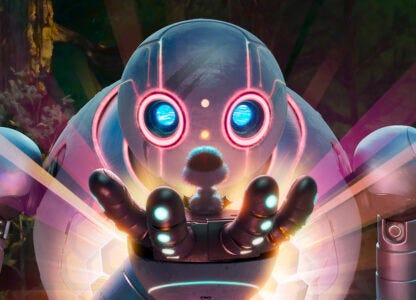The Wild Robot: Warnings (and Lessons) from a World Dominated by Big Tech and Climate Chaos
Warning: This piece contains spoilers of the film!
The OAJ is currently looking for interested students to join our team! If you’ve read our work before (or if this is your first time), and you like what we do, please email OAJ Executive Editor Paulina Campos at openair@brandeis.edu to join the journal.
The piece below is part of our weekly blog post series written by the Open-Air Journal team where we explore issues at Heller, current events, or whatever is presently on our minds.
The latest animated film to capture the imagination of moviegoers is The Wild Robot, a Dreamworks feature about a robot assistant that gets stranded in the wilderness and becomes responsible for raising an orphaned gosling. The heartwarming tale, however, exists within a world ravaged by ecological disaster and dominated by corporate power. While it is unsettling to watch a dystopian future that seems feasible given our current reality, The Wild Robot provides some lessons for maintaining hope amid the chaos. Ultimately, however, drastic action must be taken if we want to combat the twin forces of corporate greed and climate chaos.
The film’s protagonist, Rozzum 7134 (or Roz), is a robot assistant created by the fictional corporation Universal Dynamics. We learn that Roz is meant to serve as a household assistant that can help her human owner with any task. However, a large storm leaves Roz shipwrecked in the wild. Searching for her first task, she encounters a world that is incompatible with her programming. While she gets her bearings, Roz accidentally kills a goose and its goslings. However, one egg remains. The baby gosling, Brightbill, presents the ultimate task for Roz: motherhood. While her task involves just three steps (teach the gosling to eat, swim, and fly in time for the winter migration), the journey requires her to override her programming as she’s faced with the messiness of parenthood.
Roz’s trial and error as she acclimates to her new life echo many of the complaints we have about AI tools today. The most problematic being that generative AI is “eager to provide answers,” presenting “probabilistic” solutions confidently even when they are wrong or dangerous. One famous example is Google’s AI Overview, which told searchers to add glue to pizza to help the cheese stay on the crust. However, not every mistake made by AI will be as innocuous. In Roz’s case, her attempts to survive in the wild on her programming alone lead to the accidental killing of Brightbill’s family, an indication of the senseless destruction that we may allow to occur while AI works out the kinks. It is telling that Roz makes the most progress only when she overrides her programming and begins to embrace nuance and imperfection. In our case, however, we cannot rely on AI to gain the capacity to think creatively like a human, as much as we might cling to this fantasy.
Ultimately, Roz’s corporate owners must retrieve their product. They send a giant UFO-like warship with the express goal to retrieve the valuable data Roz has acquired during her time in the wild. This was all too familiar. Consumers today have become accustomed to the idea that most organizations are hungry for their data. We pay for free online services with our data and privacy that is sold to advertisers, and now our social media posts are training generative AI. Companies like OpenAI and Anthropic are already running out of data on the internet to train their models, and are hungry for “larger oceans of information.”
To this end, Universal Dynamics was willing to destroy Roz and her forest home. When their army of robots fails to capture her, the warship begins launching rockets and sets the forest ablaze in a scene reminiscent of increasingly common forest fires across the globe. Similarly, AI companies like Elon Musk’s xAI are ready and willing to abuse our natural resources to power their supercomputers, which run on massive amounts of water and electricity. It is well documented that as corporations continue to burn fossil fuels, the impacts of climate change will not only cause long-term changes like sea level rise but will make weather more chaotic and difficult to predict. We see glimpses of these consequences in The Wild Robot’s universe – as the geese migrate for winter, they fly above a Golden Gate Bridge almost completely submerged in water.
As the director of the film himself says, The Wild Robot introduces themes of environmental degradation and climate change gently to its child viewers as a backdrop to the primary narrative of Roz’s personal journey. The lessons that come from Roz’s journey, however, can be applied to these larger crises. For instance, the animals in the film come together in solidarity to help their friends and combat the threat to their home. In our own fight against corporate greed, solidarity and mass organizing are essential. Further, the film ends not with Roz remaining in the forest but returning to Universal Dynamics headquarters. The outcome represents a balance between technology and nature, an acknowledgement that just because Roz can exist in the natural world, does not mean that she should. In order to preserve our world’s natural environment, we will need to strike this balance and discern where human intervention is helpful and where it is harmful. These lessons can help us address the runaway corporate growth and unregulated technological advancement that could lead to the dystopian future captured in the film.




